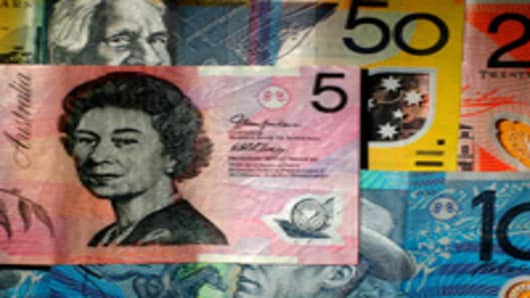The prospect of lower interest rates often means one thing in financial markets– a weaker currency. But that does not appear to be the case with the Australian dollar, which is expected to stay strong even as the nation's central bank looks set to cut interest rates again this week.
The Reserve Bank of Australia (RBA) has slashed its benchmark borrowing rate by 100 basis points since May in the face of a softer jobs market, falling prices for some of Australia's major commodities exports and a weak global economy.
Economists polled by Reuters expect the RBA, which cut rates just a month ago, to deliver a further 25 basis point cut in the key cash rate to 3 percent at a policy meeting on Tuesday. Although markets are more divided on the prospects for a rate cut this week amid mixed economic data.
While the Aussie dollar would probably dip in reaction to any rate cut on Tuesday, the bottom line for the currency is that interest rates will remain relatively high and continue to be a source of underlying support, analysts told CNBC.
"The Aussie dollar is going to remain resilient whether the RBA cuts interest rates or not," said Nick Maroutsos, managing director at Kapstream Capital in Sydney.
"You have a situation where the Australian dollar can function as a carry currency and a defensive currency because interest rates are relatively high, Australia is also one of the few triple-A rated countries out there," he said, referring to the country's investment grade credit rating.
(Read More: RBA Lifts 2012 Growth Forecast, Warns on Aussie)
Even if the RBA cuts its cash rate to 3 percent, as expected, Australian interest rates will remain higher than those of the U.S., Europe, the UK and Japan – all of which have interest rates below 1 percent with most close to zero.
Buying Interest
In the wake of last month's rate cut, the Aussie dollar fell to a three-month low at about $1.01 to the greenback, shedding about 1.5 percent. But it has since rebounded, trading at about $1.03 on Monday, or about 7.5 percent above a June low of $0.9579.
"With the Aussie dollar, anything around parity with the U.S. dollar and we are going to be natural buyers and I think central banks and other asset managers would be as well," said Maroutsos. "We could see it top out at $1.04, $1.05, $1.06 (to the U.S. dollar) but I think it will remain resilient."
David Greene, Senior Corporate FX Dealer at Western Union Business Solutions in Sydney agreed that any move in the Aussie below parity with its U.S. counterpart would be met with buying interest.
"A potential rate cut is priced into the market, so the Aussie may come off and test the $1.01 area straight after the announcement. But anything below parity and global central banks jump in, so it (the Aussie dollar) is pretty much well supported," Greene said on "Squawk Box".
Foreign central banks and sovereign wealth funds have been buying Australia government bonds at a record pace this year in bid to diversify their holdings and take advantage of the high yields offered in Australia.
No Rate Cut?
For some analysts, there was scope for the Australian dollar to push higher if the central bank keeps interest rates steady.
Unlike most economists, financial markets appear to be more divided about the prospects of a rate cut this week, with the interbank futures market pricing in a probability of 42 percent, according to Reuters.
Mixed economic data on Monday suggest the RBA decision could be a close one: September retail sales rose a higher–than-expected 0.5 percent from a month earlier, when they rose a 0.3 percent.
Data from Australian bank ANZ meanwhile showed job advertisements across Australia fell 4.6 percent in October, the seventh straight months of falls and a bad sign for the jobs market, while a private gauge of Australian inflation rose just 0.1 percent in October from a month earlier.
"Our view is that they (RBA) will not cut on Tuesday, and that could actually see the Aussie dollar go up to 1.05 (per U.S. dollar) in the short-term," Nizam Idris, head of strategy for fixed income and currencies at Macquarie Bank, told CNBC.
Analysts said interest rates in Australia would need to fall to around 2 percent for them to really make a dent in the value of the local currency.



